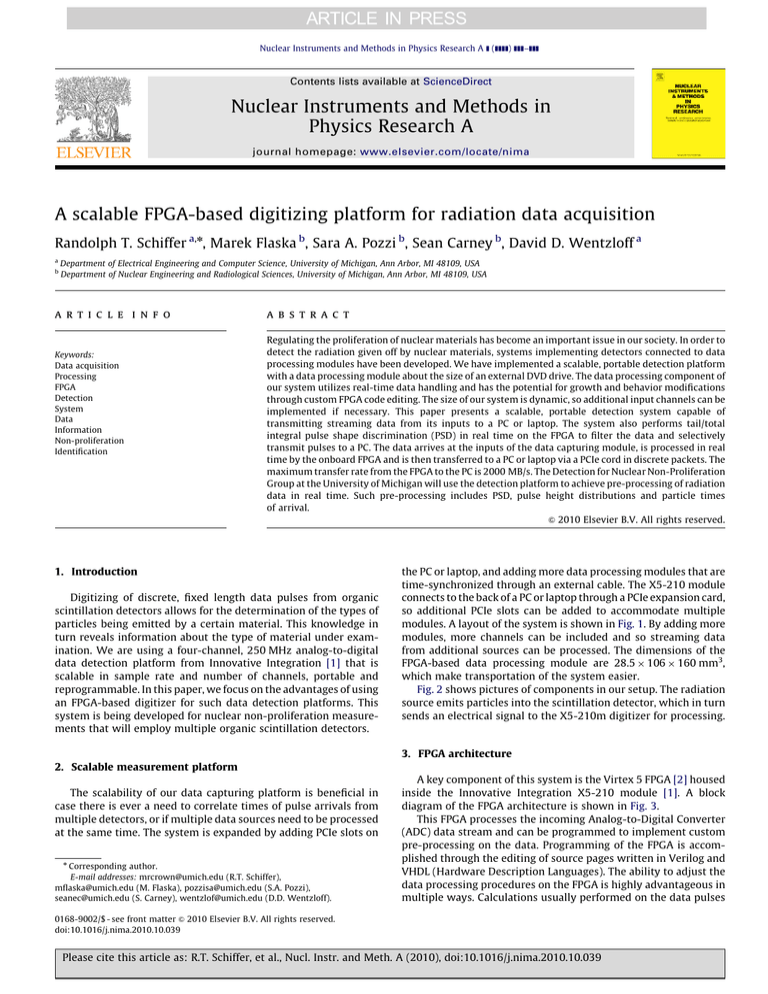
Nuclear Instruments and Methods in Physics Research A ] (]]]]) ]]]–]]]
Contents lists available at ScienceDirect
Nuclear Instruments and Methods in
Physics Research A
journal homepage: www.elsevier.com/locate/nima
A scalable FPGA-based digitizing platform for radiation data acquisition
Randolph T. Schiffer a,n, Marek Flaska b, Sara A. Pozzi b, Sean Carney b, David D. Wentzloff a
a
b
Department of Electrical Engineering and Computer Science, University of Michigan, Ann Arbor, MI 48109, USA
Department of Nuclear Engineering and Radiological Sciences, University of Michigan, Ann Arbor, MI 48109, USA
a r t i c l e in f o
Keywords:
Data acquisition
Processing
FPGA
Detection
System
Data
Information
Non-proliferation
Identification
abstract
Regulating the proliferation of nuclear materials has become an important issue in our society. In order to
detect the radiation given off by nuclear materials, systems implementing detectors connected to data
processing modules have been developed. We have implemented a scalable, portable detection platform
with a data processing module about the size of an external DVD drive. The data processing component of
our system utilizes real-time data handling and has the potential for growth and behavior modifications
through custom FPGA code editing. The size of our system is dynamic, so additional input channels can be
implemented if necessary. This paper presents a scalable, portable detection system capable of
transmitting streaming data from its inputs to a PC or laptop. The system also performs tail/total
integral pulse shape discrimination (PSD) in real time on the FPGA to filter the data and selectively
transmit pulses to a PC. The data arrives at the inputs of the data capturing module, is processed in real
time by the onboard FPGA and is then transferred to a PC or laptop via a PCIe cord in discrete packets. The
maximum transfer rate from the FPGA to the PC is 2000 MB/s. The Detection for Nuclear Non-Proliferation
Group at the University of Michigan will use the detection platform to achieve pre-processing of radiation
data in real time. Such pre-processing includes PSD, pulse height distributions and particle times
of arrival.
& 2010 Elsevier B.V. All rights reserved.
1. Introduction
Digitizing of discrete, fixed length data pulses from organic
scintillation detectors allows for the determination of the types of
particles being emitted by a certain material. This knowledge in
turn reveals information about the type of material under examination. We are using a four-channel, 250 MHz analog-to-digital
data detection platform from Innovative Integration [1] that is
scalable in sample rate and number of channels, portable and
reprogrammable. In this paper, we focus on the advantages of using
an FPGA-based digitizer for such data detection platforms. This
system is being developed for nuclear non-proliferation measurements that will employ multiple organic scintillation detectors.
the PC or laptop, and adding more data processing modules that are
time-synchronized through an external cable. The X5-210 module
connects to the back of a PC or laptop through a PCIe expansion card,
so additional PCIe slots can be added to accommodate multiple
modules. A layout of the system is shown in Fig. 1. By adding more
modules, more channels can be included and so streaming data
from additional sources can be processed. The dimensions of the
FPGA-based data processing module are 28.5 106 160 mm3,
which make transportation of the system easier.
Fig. 2 shows pictures of components in our setup. The radiation
source emits particles into the scintillation detector, which in turn
sends an electrical signal to the X5-210m digitizer for processing.
3. FPGA architecture
2. Scalable measurement platform
The scalability of our data capturing platform is beneficial in
case there is ever a need to correlate times of pulse arrivals from
multiple detectors, or if multiple data sources need to be processed
at the same time. The system is expanded by adding PCIe slots on
n
Corresponding author.
E-mail addresses: mrcrown@umich.edu (R.T. Schiffer),
mflaska@umich.edu (M. Flaska), pozzisa@umich.edu (S.A. Pozzi),
seanec@umich.edu (S. Carney), wentzlof@umich.edu (D.D. Wentzloff).
A key component of this system is the Virtex 5 FPGA [2] housed
inside the Innovative Integration X5-210 module [1]. A block
diagram of the FPGA architecture is shown in Fig. 3.
This FPGA processes the incoming Analog-to-Digital Converter
(ADC) data stream and can be programmed to implement custom
pre-processing on the data. Programming of the FPGA is accomplished through the editing of source pages written in Verilog and
VHDL (Hardware Description Languages). The ability to adjust the
data processing procedures on the FPGA is highly advantageous in
multiple ways. Calculations usually performed on the data pulses
0168-9002/$ - see front matter & 2010 Elsevier B.V. All rights reserved.
doi:10.1016/j.nima.2010.10.039
Please cite this article as: R.T. Schiffer, et al., Nucl. Instr. and Meth. A (2010), doi:10.1016/j.nima.2010.10.039
2
R.T. Schiffer et al. / Nuclear Instruments and Methods in Physics Research A ] (]]]]) ]]]–]]]
after they have been recorded can be done in real time on the FPGA
as the data is streaming in. This significantly reduces the overall
time required for processing pulses. Furthermore, pulses can be
cleaned (e.g. remove clipped signals, etc.) and the appropriate
information extracted (e.g. gamma/neutron discrimination, pulse
height, etc.) on the FPGA, eliminating the need to transmit raw
pulse data to the PC entirely. For example, for tests recording pulse
data, we typically use around 1 TB of storage space on the PC for
acceptable statistical analysis. Pre-processing on the FPGA can
reduce this by nearly 100 , which is much more manageable.
As data streams from the ADC channels, the data values are
synchronously compared to a programmable trigger threshold
value at a rate of 250 MHz and when the input values achieve the
user-specified comparison, a trigger event occurs and data capture
begins. The data acquisition rate is limited by three factors: (1) the
memory on the FPGA module is 512 MB of DRAM and 4 MB of
SRAM, (2) transfer rate over the PCIe link from FPGA to PC of
2000 MB/s and (3) Memory on the PC [1]. The number of data
samples to be captured every trigger event is user-specified.
When a trigger event occurs, if we began capturing the incoming
data at that exact moment in time, we would miss the beginning of the
overall waveform. Therefore, in order to capture the entire waveform,
we implement a pre-trigger on the FPGA that buffers the incoming data
for a programmable number of samples (DT). In this manner, when a
trigger event occurs, the start time of the data acquisition becomes the
trigger time minus the pre-trigger interval DT.
A software program on the PC side created by Innovative
Integration [1] allows the user to specify parameters related to
data streaming, such as how much data to capture, the manner in
which the X5-210 digitizer should trigger (whether from software
or hardware), the trigger threshold, etc. Through, this software
program the user is able to write numeric values to registers on the
FPGA over the PCIe link. These register-stored values are in turn
used in custom logic programmed on the FPGA. For example, the
trigger threshold value used to mark the beginning of data capture
is written to a certain register on the FPGA via this program.
Every trigger event, a specified number of samples (usually 256)
is captured and sent to the PC or laptop. The first 100 samples of the
waveform associated with each trigger event are actual data
samples recorded from the ADC input channel. We reserve 20
data samples for information specific to the pulse window in a
footer. The footer information includes which of the four channels
triggered, a timestamp of the trigger event, the total and tail
integral of the pulse, a bit indicating whether or not the pulse is
clipped at the limit of the input range, two bits indicating the result
of a pulse shape discrimination comparison, plus supplementary,
unused bits available for future expansion and debugging. The
structure of data for each pulse waveform is shown in Fig. 4. In the
software on the PC, these footer samples are treated as recorded
data samples that arrived at the ADC inputs, but in reality they
contain custom information of our choice. After all the data is saved
on the PC, we use custom software to strip off the footer
Fig. 1. Overall data capture system.
Fig. 4. Pulse data structure.
Fig. 3. FPGA architecture.
Fig. 2. Radiation sources (left) and standard liquid scintillation detector (right).
Please cite this article as: R.T. Schiffer, et al., Nucl. Instr. and Meth. A (2010), doi:10.1016/j.nima.2010.10.039
R.T. Schiffer et al. / Nuclear Instruments and Methods in Physics Research A ] (]]]]) ]]]–]]]
3
These measurement results were obtained with a Cf-252 source
placed 15 cm from an EJ-309 liquid scintillation detector. Neutrons
produce larger tail integrals than gamma rays, which can be clearly
seen in the plot. The measurement threshold was set to 80 keVee
(keV electron equivalent).
The algorithm on the FPGA used to distinguish between
neutrons and gamma rays (whose result is stored in the footer
of the pulse waveforms) checks if the tail integral is less than
(a total+b), where a and b are linear line coefficients. This line
intersects directly between the neutron and gamma ray clusters
(shown in Fig. 5), so if the tail integral is above this line for a given
total integral, the pulse is marked as a gamma ray, otherwise it is
marked as a neutron.
4. Conclusions
Fig. 5. FPGA measurements.
X5-210m Work Completed
Real-time tail and total integral calculation of
incoming pulses.
Real-time Pulse Shape Discrimination (PSD)
calculation.
Real-time check for clipped pulses implemented.
Baseline offset calculation implemented.
The final goal of this work is to pre-process liquid scintillator
detector data in real time through custom modifications to
the FPGA for the purpose of identifying special nuclear materials.
A summary of all of the work completed on this platform is
shown in Fig. 6. Some of the applications stemming from the
ability to identify special nuclear materials include nuclear nonproliferation, safeguards and national security. Using such a
detection system in airports and coastal shipping ports to screen
the movement of nuclear materials into and out of the country
could be one of the most direct applications of this data detection
system. Special nuclear materials emit radiation and so our
detection platform would be able to detect these materials.
Timestamp for one channel correctly implemented.
Real-time check for double pulses implemented.
Fig. 6. Summary table.
information and perform additional post-processing on the pulses.
For example, Fig. 5 shows a plot of tail and total integrals calculated
by the FPGA in real time and transmitted to the PC in the footers,
overlaid by the same plot of tail and total integrals calculated in
Matlab on the pulse data after the pulses had been captured.
A clear distinction can be seen between neutrons and gamma
rays in Fig. 5 of the tail-to-total integrals of captured waveforms.
Acknowledgement
This research was funded by the National Science Foundation
and the Domestic Nuclear Detection Office of the Department of
Homeland Security through the Academic Research Initiative
Award # CMMI 0938909.
References
[1] X5-210M User’s Manual, Innovative Integration, February 5, 2009 [online],
/http://www.innovative-dsp.com/support/docs.htmS.
[2] Virtex-5FPGA User Guide, Xilinx Inc., November 2009 [online], /http://www.
xilinx.com/support/documentation/virtex-5.htmS.
Please cite this article as: R.T. Schiffer, et al., Nucl. Instr. and Meth. A (2010), doi:10.1016/j.nima.2010.10.039



